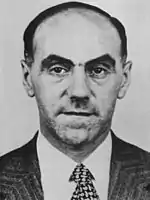Cramer v. United States
Cramer v. United States, 325 U.S. 1 (1945), was a case in which the Supreme Court of the United States reviewed the conviction of Anthony Cramer, a German-born naturalized citizen, for treason.

| Cramer v. United States | |
|---|---|
 | |
| Argued March 9, 1944 Reargued November 6, 1944 Decided April 23, 1945 | |
| Full case name | Anthony Cramer v. United States |
| Citations | 325 U.S. 1 (more) 65 S. Ct. 918; 89 L. Ed. 1441; 1945 U.S. LEXIS 2157 |
| Case history | |
| Prior | United States v. Cramer, 137 F.2d 888 (2d Cir. 1943); judgement for the plaintiff |
| Holding | |
| A conviction for treason must meet the definition given in Article III of the Constitution. | |
| Court membership | |
| |
| Case opinions | |
| Majority | Jackson, joined by Roberts, Frankfurter, Murphy, Rutledge |
| Dissent | Douglas, joined by Stone, Black, Reed |
| Laws applied | |
| U.S. Const. art. III § 3 | |
Background
Anthony Cramer, a German-born mechanic, had associated with two Germans, Werner Thiel and Edward Kerling, one of whom he had prior business dealings with.[1] The two were later found to be in the United States for the purpose of sabotage, as part of Operation Pastorius (see Ex parte Quirin). In the aftermath of the failure of that operation,[2] Cramer was also arrested and convicted on the basis of this association.[3][4] Judge Henry W. Goddard set his prison term at 45 years, along with a fine of $10,000.[5]
Cramer appealed his conviction to the Court of Appeals for the Second Circuit, where his conviction was upheld.[6]
Appealing to the court of last resort, the Supreme Court, Cramer was granted certiorari on November 8, 1943.[7]
The case was originally argued on March 9, 1944;[8] reargued on November 6, 1944;[9] and finally decided on April 23, 1945.[10]
Before the Supreme Court, Harold Medina appeared as the lawyer for Cramer, while Solicitor General Charles Fahy defended the actions of the government.[9]
Opinion of the Court
The Court decided five-to-four to overturn the jury verdict. Writing for the majority, Justice Robert H. Jackson said that the constitution is clear in its definition of treason, limited to the waging of war, or giving material assistance to an enemy. The prosecution and its witnesses could demonstrate only an association and not that Cramer had given "Aid and Comfort," as defined in Article Three. Jackson wrote that the jury had been given no evidence that Cramer had "even paid for their drinks." As such, the majority opinion held, the associations were insufficient to convict Cramer for treason, and the judgment of the Court of Appeals was reversed.
Writing in dissent, Justice William O. Douglas claimed that acts, though innocent by nature, may serve a treasonous plan. Chief Justice Harlan Fiske Stone concurred with the dissent.
See also
- Ex parte Bollman: an earlier treason case before the Court.
References
- "TREASON CHARGED TO FRIEND OF SPY; First Indictment of Its Kind Here in This War Names Man as Invader's Aide". The New York Times. September 1, 1942. Retrieved 2018-06-14.
- Wood, Lewis (July 14, 1942). "8 MEN, 6 WOMEN HELD AS U.S. AIDES TO NAZI SABOTEURS; FBI Announces Arrests in New York and Chicago -- Wife of Leader Among Prisoners PICKED BY HIGH COMMAND Group Hid Money, Bought Car, Cashed Bills for Those Now Being Tried by Army 14 HELD AS AIDES TO NAZI SABOTEURS". The New York Times. Retrieved 2018-06-14.
- "CRAMER CONVICTED IN TREASON CASE; Naturalized German Is Facing Death for Helping Thiel, Executed Nazi Spy CRAMER CONVICTED IN TREASON CASE". The New York Times. November 19, 1942. Retrieved June 13, 2018.
- Howard, J. Woodford (1986). "Advocacy in Constitutional Choice: The Cramer Treason Case, 1942-1945". American Bar Foundation Research Journal. 11 (3): 375–413. JSTOR 828139.
- "CRAMER TO PRISON FOR 45-YEAR TERM; Befriender of Nazi Spy Is Spared Death Despite Strong Correa Plea HE IS FINED $10,000 ALSO Court's Action Due to Traitor's Only Hazy Knowledge of Saboteur's Plans". The New York Times. December 3, 1942. Retrieved 2018-06-14.
- "TREASON VERDICT UPHELD; Cramer, Aid of Nazi Saboteurs, Loses in Appeals Court". The New York Times. August 21, 1943. Retrieved 2018-06-14.
- "HIGH COURT TO HEAR CRAMER ON APPEAL; Grants Review of Conviction for Treason -- $40,000,000 Optical Suit Is Dismissed TRIBUNAL SPLIT ON ISSUE Concerns Accused of Plot on Instruments -- Gene McCann Wins Another Pleading". The New York Times. November 9, 1943. Retrieved 2018-06-14.
- "SIXTY CASES AWAIT HIGH COURT RULING; Thirty Are Ready for Decision as the Justices Sit Today -- Insurance Issue Awaited 114 DISSENTS IN THIS TERM Visitors Increase as a Result -- Next Session April 24 and Adjournment About June 1". The New York Times. April 10, 1944. Retrieved 2018-06-14.
- Walz, Jay (November 7, 2018). "HIGH COURT WEIGHS FIRST TREASON CASE; Intent of Framers of Constitution Described in Arguments Appealing Cramer Conviction SUIT TURNS ON 'OVERT ACT' Defense Counsel Says Meeting With Nazi Saboteurs Was Not Actually Traitorous". The New York Times. Retrieved 2018-06-14.
- Wood, Lewis (April 24, 2018). "CRAMER IS CLEARED IN TREASON CASE; Supreme Court in 5-to-4 Vote Reverses Conviction of New Yorker as Saboteur Aide NEW COMPLAINT POSSIBLE Minority Calls the Conclusion 'Ludicrous'--First Test of Law in Court's History". The New York Times. Retrieved 2018-06-14.
External links
 Works related to Cramer v. United States (325 U.S. 1) at Wikisource
Works related to Cramer v. United States (325 U.S. 1) at Wikisource- Text of Cramer v. United States, 325 U.S. 1 (1945) is available from: CourtListener Findlaw Google Scholar Justia Library of Congress